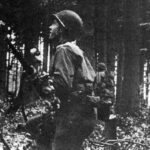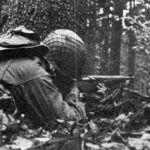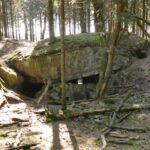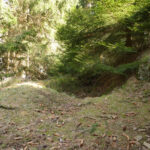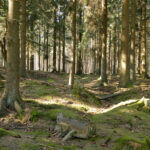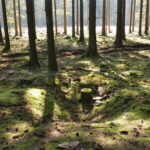Episodes of War: The battles in and around the Hürtgen Forest in autumn and winter of 1944/45 (Published on 18/03/2022, updated on 08/06/2022)
Inseparably linked with the activities of Julius Erasmus are the battles in and around the Hürtgen Forest during the Second World War, which lasted – with interruptions – from September 1944 to February 1945. Many of the fallen soldiers recovered by Julius Erasmus and his helpers and buried in the military cemetery in Vossenack died in these battles.
For the reader who is not familiar with these battles and their special nature, they will afterwards be described in more detail, however, with no more than a general overview.
I. The region of “Hürtgen Forest” and its conditions during the Second World War
Today’s name Hürtgenwald is a result of the fighting in the Second World War, when the Americans named the extensive forest areas of the forests of Hürtgen, Merode, Roetgen and Wenau in their entirety as “Hurtgen Forest” in reference to the village Hürtgen – and also the English term “to hurt”. It is an area of about 140 km2, roughly extending between the Belgian border, Eschweiler in the north and Monschau in the south, and bordered by the Rur river in the east. There, in the fall and winter of 1944/45, the most severe battles took place, which, not least because of the external circumstances, have burned themselves lastingly into the memory of all those affected, soldiers and the civilian population alike.
A large part of the battle area at that time consisted of very dense and thus difficult to penetrate forests, the character of which is not comparable with today’s. At that time, the dense forest was widespread up to the immediate edge of today’s federal highway 399, which already existed at that time; many of the meadow and pasture areas adjacent to it today were created only as a result of the destruction caused by the fighting. The former dense forest areas and the already highly dissected landscape were accompanied by a limited network of roads and paths, which made military movements even more difficult. The Siegfried Line with numerous bunkers also ran through the area. In addition, the weather in the fall of 1944 was unusually wet and cold, even for the conditions in the northern Eifel, with an early onset of winter.
II. Goals and course of the battles
While the US troops, advancing essentially from the west and southwest, wanted to take possession of the high ground around the village of Schmidt on the other side of the Kall valley, especially to protect the further advance toward the Rhine, the Wehrmacht doggedly tried to hold its lines of defense, not least in view of the strategic importance the nearby Rur reservoirs had to them and as regards the preparations for the later Ardennes offensive (cf. on this and on the course of the fighting in detail e. g. Hammel, Vor 40 Jahren: Die Schlacht im Hürtgenwald, in: Truppenpraxis 1984, p. 745 ff., p. 823 ff. und 1985, p. 85 ff.).
Since the local conditions and the persistently bad weather severely limited the deployment of both larger tank units and the air force, the fighting was dominated by infantry, engineers and artillery, which struggled for about five months for woods and parts of woods, for aisles, roads and villages. The fighting began on 14 September 1944 with the first US attacks in the Roetgen/Lammersdorf area and ended on 7 February 1945 with the capture of Schmidt, after the German defenders had shortly before abandoned the last Siegfried Line bunkers still in their possession in the Ochsenkopf/Kallbrück area. In between, there were fierce, victim-rich battles between the advancing US troops and the defending units of the Wehrmacht, the latter, in the fifth year of the war, often made up of inadequately trained, poorly equipped soldiers of an advanced or a very young age, not rarely meeting their deaths quickly. In his book “Hürtgenwald – Das Verdun des Zweiten Weltkriegs” [“Hürtgenwald – The Verdun of the Second World War”] from 1953, the combat participant Baptist Palm, later mayor of Vossenack, comments as follows (ibid., p. 20 f., translation from German):
“German soldiers came and brought ammunition to the front which was five kilometers away. Weary and tired figures they were. Men from forty to forty-five years old, fathers of families and young boys of barely seventeen, each heavily packed with ammunition pulled them forward. In their faces you could see no courage, no fighting spirit, silently they crept along the edges of the forest to the front.”
III. Memories of soldiers involved
The battles in and around the Hürtgen Forest are the subject of numerous publications of varying quality, especially in the US (e. g. the works of MacDonald, “The Siegfried Line Campaign” and “The Battle of the Huertgen Forest”), but also in Germany (e.g. Hohenstein/Trees, “Hölle im Hürtgenwald” [“Hell in Huertgen Forest”]). In addition, mainly US soldiers involved in the battles have described their memories in books and thus preserved them for posterity (e.g. Wilson, “If you survive” or Boesch, “Road to Huertgen”), this has happened on the German side to a much lesser extent. However, there are some quite detailed interviews with German participants in the battles (cf. e.g. the interviews with Paul Brückner, Günter Stüttgen or Edmund Zalewski (all in German language)).
A vivid impression of the nightmarish memories the fighting left on US soldiers is conveyed, for example, by the books of George Wilson, William F. Meller, and Paul Boesch, who fought with the 4th (Wilson) and 28th US Infantry Divisions in the Hürtgen Forest.
In his 1987 book “If you survive”, Wilson describes the conditions of combat as follows (ibid., p. 132):
“We bivouacked in very rugged, roller-coaster terrain deep in the forest east of Zweifall, Germany, near the middle of the Hürtgen, a one hundred-square-mile forest of extremely steep hills, rough ridges, and deep ravines covered with oak, maple, birch, scrub oak, white pine, and jack pine. Some growths of hardwood were over one hundred feet tall; pines of mixed heights of about ten to fifty feet were planted in closely packed rows. Now and then we would see a giant stand reaching up almost one hundred feet.
The country was obstacle enough in itself, yet the Germans had two additional advantages. They always knew exactly where we were, having just left there themselves, and thus easily called down shelling on us. They also had prepared in advance a series of defensive positions. After they had made our attack as costly as possible, they simply pulled back a few hundred yards to their next emplacements – and bombarded the ones left to us.
Their new line usually gave them command of everything in front, being perhaps on an upward slope or near the lip of a ravine. Their bunkers were made of thick logs with a few feet of dirt on top. The bunkers were almost immune to artillery, which had to arc in overhead. They might as well have been concrete. Tree bursts bothered them very little, and there was no chance of our tanks getting anywhere near them for direct fire. The infantry had to take them the hard way, going in after them one at a time, sometimes through barbed wire.”
Wilson also describes individual battle scenes and the specifics of forest fighting (ibid., p. 135):
“Second Battalion immediately ran into a tough German defense, veterans who fought savagely from thick log bunkers and gun emplacements protected by barbed wire. From dug-in positions facing us, they put down brutally accurate mortars and artillery on our men out in the open and chewed us up with direct machine gun and rifle fire. Our casualties were dreadful. Most of our losses were inflicted by artillery and mortar shells exploding in the trees above us.
Normally, artillery shells come into the ground at a sharp angle, and their shrapnel fans out and slightly upward to the front, much of it going harmlessly into the ground or straight up into the air. When a shell explodes overhead in a tree, almost half of its shrapnel spreads out and downward like rain, and it is infinitely more lethal.
The best defense is to stand upright against a big tree, thus exposing mostly your helmet and shoulders. Instincts are strong, however, and many men could not stop themselves from hitting the ground as usual. Actually, it didn’t always make much difference, because mortars drop straight downward, and their steel splinters fan out in all directions. Thus you get hit from all directions, even from below with mines.”
In his 2012 book “Bloody Roads to Germany”, William F. Meller remembers his fighting in the Hürtgen Forest as follows (ibid., p. 76):
“My two eyes see absolutely nothing in this black. I have no brains and I can’t think. My instinct is to survive this night, but how? These thoughts tense my body. I am shivering, it’s cold, but I don’t know if it’s cold tonight or if it’s just me. I’m an animal in a hole waiting to be swallowed up. How long will this go on? I can’t stand this darkness. I’m trying so hard not to make any noise; I don’t want to breathe. I have visions of them crawling through the trees right up to the edge of this hole. I am thinking of the men who were blown apart this morning. I can still hear the awful screaming as the bodies are torn (…), spreading agonizing death around me. They are butchering us.”
Meller continues (ibid., p. 76):
“The forest was covered with a heavy growth of fir trees, some seventy-five, some a hundred feet tall, that held up the sky. Upon entering the first time, I looked-up and felt I was in a hallowed place. This forest had been the silent, graveyard for soldiers for centuries. It is cross-sectioned with well-defined firebreaks. These firebreaks were calibrated on German maps for pinpoint accuracy of their artillery. The German artillery could literally drop a shell into the coat pocket of an American soldier. And they did, often.”
Finally, a statement by Paul Boesch from his book “Road to Huertgen”, first published in 1962, is reproduced, which presumably applies to all participants in the battles in and around the Hürtgen Forest (ibid., p. 147):
“As I look back on the action in the forest, a curtain of time tries to minimize the cruel length of the days and nights and run them together in one broad picture. It is difficult to recall the sequence in which events occurred. Each episode appears to claim precedence over the others. But though it is hard to recall exactly when a thing happened, it is impossible to erase the events themselves, for the sheer, stark, exhausting terror burned them inextricably in our memory.”
This describes the circumstances under which many of the soldiers later recovered by Julius Erasmus and his helpers lost their lives. The fact that both the military cemetery in Vossenack and the one in Hürtgen contain a high proportion of unknown soldiers whose identification was not possible also speaks for itself.
(Head picture: Hürtgen Forest in the Peterberg area)
If you wish to support my work on Julius Erasmus, you can do so here. Many thanks!


